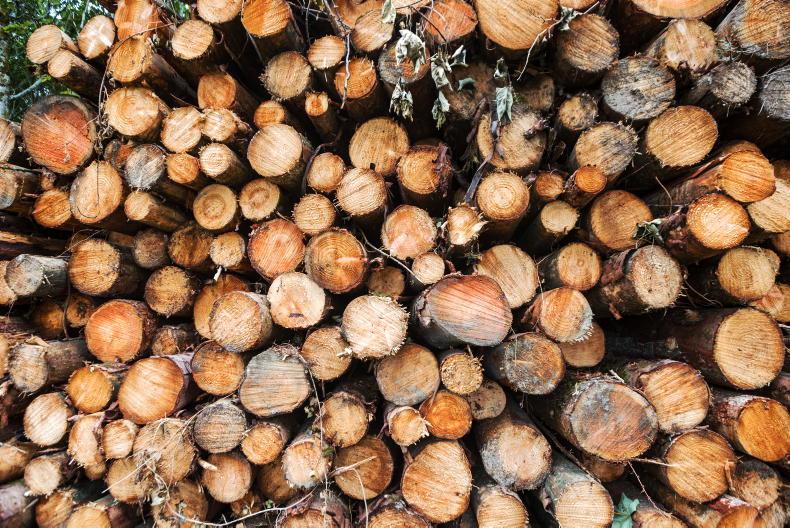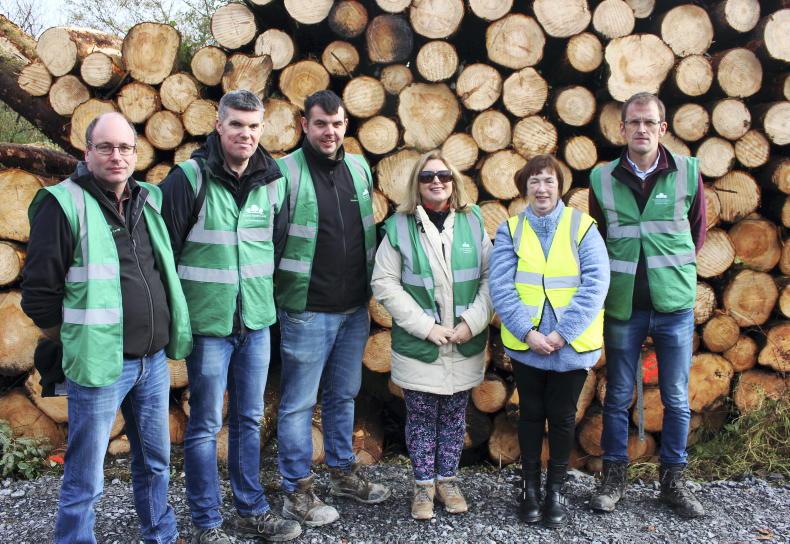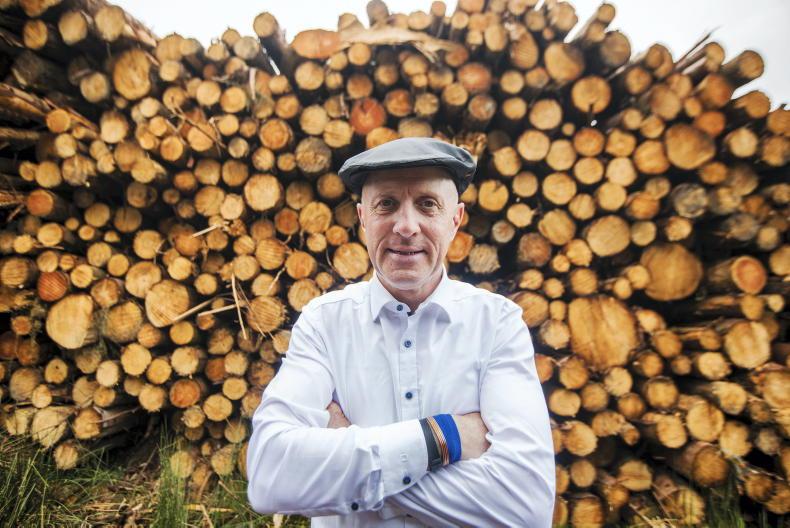Forestry’s uncertain direction is reflected in the Food Vision 2030 annual report. Forestry was always likely to take a back seat in a report that is primarily concerned with agriculture, in particular food and drink production.
Yet, the interaction between forestry and agriculture is vital to the progress of both. Successive Climate Action Plans acknowledge afforestation as “one of the largest land-based, long-term climate change mitigation measures available to Ireland.”
The first annual report, launched in 2021 – reflects on Food Vision 2030 and its implementation plan. The plan contained four missions, 22 goals and 218 actions for the agri-food sector up to 2030.
Forestry was featured strongly in a wide range of goals and actions in the implementation plan, especially in mission 1. These included the need to develop diverse multifunctional forests, to increase annual afforestation from existing levels to at least 8,000ha and double the sustainable production of biomass from forests to 2m tonnes by 2035.
It also addressed the “scope to consider the role of forests and voluntary carbon markets” and proposed the establishment of a working group “to examine the practicability of developing a carbon market to enable farmers to monetise the benefit from additional carbon sequestered on their farms”.
Farmers at the centre
It proposed the “implementation of Mackinnon recommendations including a new forestry strategy”, which is also featured in mission 2. A key action included the placing of “farmers at the centre of a new and improved afforestation scheme”. In addition to the minimum of 8,000ha of annual afforestation, it included an increase in continuous cover forestry and agro-forestry.
It also stepped outside the forest to explore ways “to develop and test new technologies and environmental solutions for the use of wood-based materials in the (re)construction and/or retrofitting of buildings as well as more novel opportunities for forest-based and forestry processing”.
The Food Vision implementation plan 2030 complements the climate action plan in many respects, which is why the 2022 Food Vision annual report is a major disappointment. It should reference the role of forestry not only in the implementation plan but also the climate action plan. It does neither.
The climate action plan is absent in Minister McConalogue’s foreword and the introduction by Minister of State Hackett. It is also absent in relation to forestry and is only mentioned twice in the 55-page document in relation to two – dairy along with beef and sheep – of the six group reports. There is no group outlining forestry activity.
Given the strong presence of forestry in mission 1 of the 2021 implementation report, it would have been expected to feature again in mission 1 of the annual report but is absent here and elsewhere.
If future Food Vision annual reports truly reflect the implementation plan and the climate action plan, then they have to outline detailed areas of progress – or lack of progress – in achieving real goals.
The close proximity of the annual report to the establishment of Food Vision 2030 may be a partial reason for lack of details. However, goals such as achieving an annual 8,000ha afforestation programme and placing farmers at the centre of afforestation are meaningless at a time when farmers are planting less than 400ha. Likewise, talk of developing carbon markets 10 years after the UK launched a Forest Carbon Code needs more than a feasibility study at this late stage.
Goals and actions need to be accompanied by key performance indicators in future Forest Vision annual reports if this initiative is to have credibility among stakeholders.
IFA conference: “A Path Forward for Farm Forestry”
The IFA Farm Forestry National Conference, A Path Forward for Farm Forestry, will take place in the Tullamore Court Hotel on Thursday 8 June 2023.
“Farmers will be pivotal to the success of the afforestation targets,” said Geraldine O’Sullivan, IFA.
“According to the recently published EPA Land Use Review report, agricultural land accounts for 67% of Ireland’s total land area, so farmers’ decisions to plant or not to plant will ultimately guide the success or failure of the forestry programme,” she added. “The announcement in November 2022 of €1.3bn funding under the new Forestry Programme including an increase in forest premium rates and the return to a 20-year premium payment for farmers felt like a turning point but the programme has stalled,” she maintained.
The conference aims to take a look at the new programme and what is on offer to farmers, as well as what they need to consider when planting and managing farm forests.
“It will explore conventional forestry, agroforestry and opportunities in forest carbon as a potential income stream.
“It will also look at ash dieback and how this needs to be urgently addressed so that the farm forestry sector can move forward in confidence,” O’Sullivan explained.
The conference will provide a platform to farmers and forest owners to ask questions “and hear directly from policymakers, advisers and professionals”, she said.
IFA president Tim Cullinan will open the conference while the keynote address will be provided by Pippa Hackett, Minister of State for Biodiversity and Land Use.
Creating a viable farm forestry sector is the theme for the opening session, which will feature Seppi Höna, Regional Forest Inspector at the Department of Agriculture, Food and the Marine, Marina Conway, Western Forestry Co-op and Dr Jim McAdam, Irish Agroforestry Forum.
Session 2 will address Understanding Forest Carbon with speakers from the Department, Teagasc and the UK Woodland Carbon Code. There will be panel discussions featuring all speakers and representatives of the IFA, the Department and Forest Industries Ireland.
Admission is free but prebooking (www.ifa.ie/ifa-farm-forestry-national-conference-2023/) is essential. Registration is between 9.30am and 10.00am.
Forestry’s uncertain direction is reflected in the Food Vision 2030 annual report. Forestry was always likely to take a back seat in a report that is primarily concerned with agriculture, in particular food and drink production.
Yet, the interaction between forestry and agriculture is vital to the progress of both. Successive Climate Action Plans acknowledge afforestation as “one of the largest land-based, long-term climate change mitigation measures available to Ireland.”
The first annual report, launched in 2021 – reflects on Food Vision 2030 and its implementation plan. The plan contained four missions, 22 goals and 218 actions for the agri-food sector up to 2030.
Forestry was featured strongly in a wide range of goals and actions in the implementation plan, especially in mission 1. These included the need to develop diverse multifunctional forests, to increase annual afforestation from existing levels to at least 8,000ha and double the sustainable production of biomass from forests to 2m tonnes by 2035.
It also addressed the “scope to consider the role of forests and voluntary carbon markets” and proposed the establishment of a working group “to examine the practicability of developing a carbon market to enable farmers to monetise the benefit from additional carbon sequestered on their farms”.
Farmers at the centre
It proposed the “implementation of Mackinnon recommendations including a new forestry strategy”, which is also featured in mission 2. A key action included the placing of “farmers at the centre of a new and improved afforestation scheme”. In addition to the minimum of 8,000ha of annual afforestation, it included an increase in continuous cover forestry and agro-forestry.
It also stepped outside the forest to explore ways “to develop and test new technologies and environmental solutions for the use of wood-based materials in the (re)construction and/or retrofitting of buildings as well as more novel opportunities for forest-based and forestry processing”.
The Food Vision implementation plan 2030 complements the climate action plan in many respects, which is why the 2022 Food Vision annual report is a major disappointment. It should reference the role of forestry not only in the implementation plan but also the climate action plan. It does neither.
The climate action plan is absent in Minister McConalogue’s foreword and the introduction by Minister of State Hackett. It is also absent in relation to forestry and is only mentioned twice in the 55-page document in relation to two – dairy along with beef and sheep – of the six group reports. There is no group outlining forestry activity.
Given the strong presence of forestry in mission 1 of the 2021 implementation report, it would have been expected to feature again in mission 1 of the annual report but is absent here and elsewhere.
If future Food Vision annual reports truly reflect the implementation plan and the climate action plan, then they have to outline detailed areas of progress – or lack of progress – in achieving real goals.
The close proximity of the annual report to the establishment of Food Vision 2030 may be a partial reason for lack of details. However, goals such as achieving an annual 8,000ha afforestation programme and placing farmers at the centre of afforestation are meaningless at a time when farmers are planting less than 400ha. Likewise, talk of developing carbon markets 10 years after the UK launched a Forest Carbon Code needs more than a feasibility study at this late stage.
Goals and actions need to be accompanied by key performance indicators in future Forest Vision annual reports if this initiative is to have credibility among stakeholders.
IFA conference: “A Path Forward for Farm Forestry”
The IFA Farm Forestry National Conference, A Path Forward for Farm Forestry, will take place in the Tullamore Court Hotel on Thursday 8 June 2023.
“Farmers will be pivotal to the success of the afforestation targets,” said Geraldine O’Sullivan, IFA.
“According to the recently published EPA Land Use Review report, agricultural land accounts for 67% of Ireland’s total land area, so farmers’ decisions to plant or not to plant will ultimately guide the success or failure of the forestry programme,” she added. “The announcement in November 2022 of €1.3bn funding under the new Forestry Programme including an increase in forest premium rates and the return to a 20-year premium payment for farmers felt like a turning point but the programme has stalled,” she maintained.
The conference aims to take a look at the new programme and what is on offer to farmers, as well as what they need to consider when planting and managing farm forests.
“It will explore conventional forestry, agroforestry and opportunities in forest carbon as a potential income stream.
“It will also look at ash dieback and how this needs to be urgently addressed so that the farm forestry sector can move forward in confidence,” O’Sullivan explained.
The conference will provide a platform to farmers and forest owners to ask questions “and hear directly from policymakers, advisers and professionals”, she said.
IFA president Tim Cullinan will open the conference while the keynote address will be provided by Pippa Hackett, Minister of State for Biodiversity and Land Use.
Creating a viable farm forestry sector is the theme for the opening session, which will feature Seppi Höna, Regional Forest Inspector at the Department of Agriculture, Food and the Marine, Marina Conway, Western Forestry Co-op and Dr Jim McAdam, Irish Agroforestry Forum.
Session 2 will address Understanding Forest Carbon with speakers from the Department, Teagasc and the UK Woodland Carbon Code. There will be panel discussions featuring all speakers and representatives of the IFA, the Department and Forest Industries Ireland.
Admission is free but prebooking (www.ifa.ie/ifa-farm-forestry-national-conference-2023/) is essential. Registration is between 9.30am and 10.00am.










SHARING OPTIONS